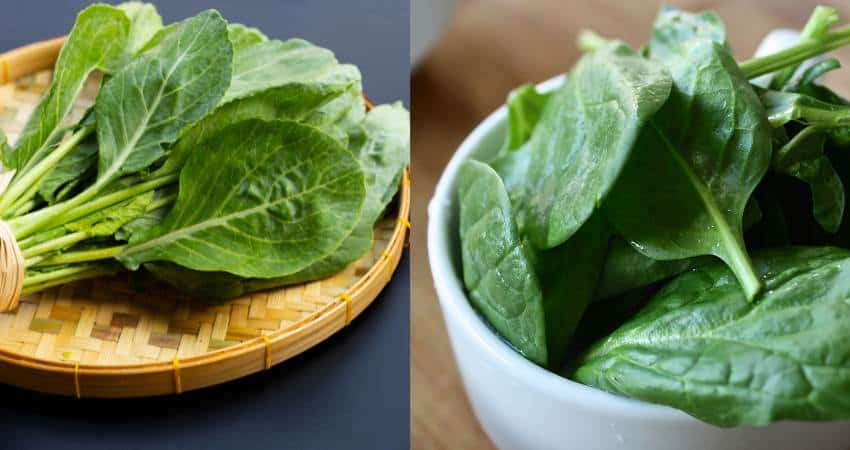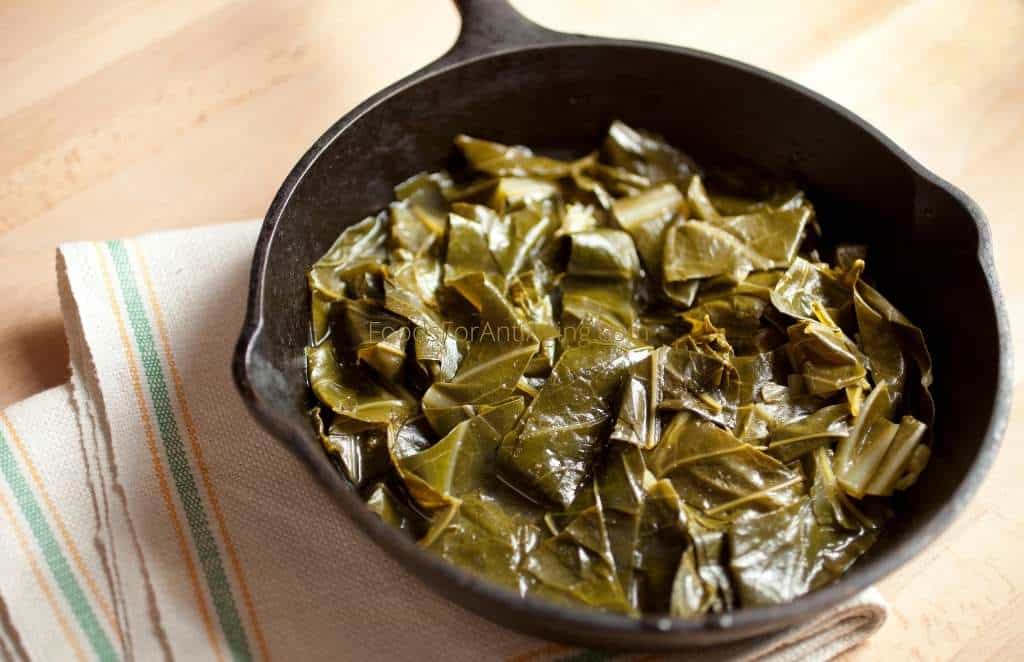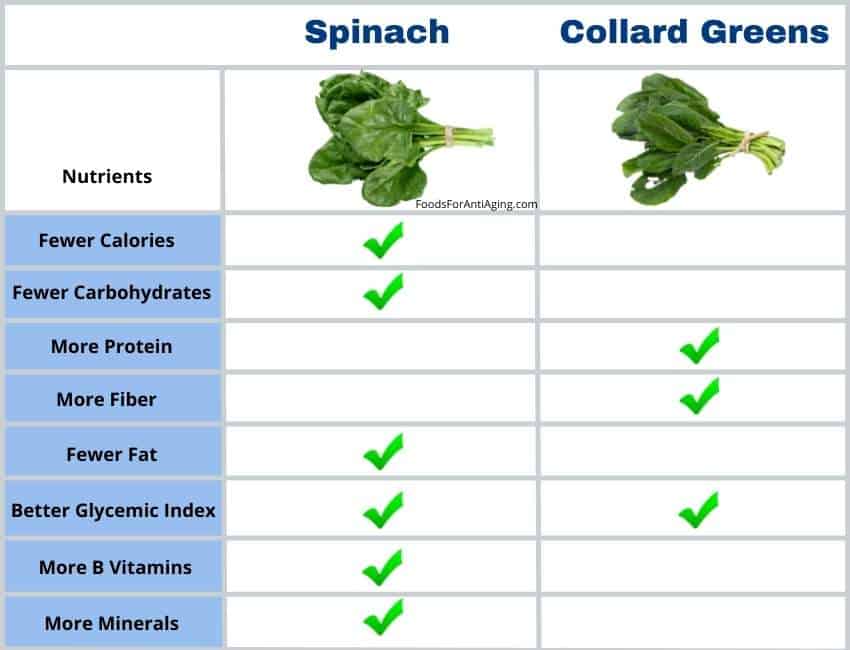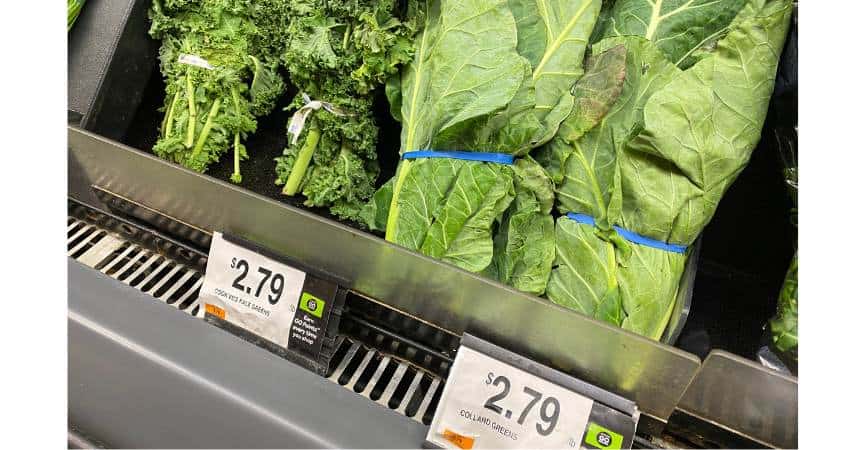Collard Greens vs Spinach: Which Greens is Better?
As a Certified Health Coach part of my role is to educate people about healthy foods like collard greens and spinach. Both should be included in a healthy diet but many people wonder about their differences.
Let’s answer, what is the difference between collard greens and spinach?
Collard greens are a leafy vegetable from the brassica oleracea species while spinach is from the Amaranthaceae family. Collard greens have larger leaves than spinach and taste more bitter. Spinach’s texture is softer and more delicate. Collards have more fiber but spinach has more minerals and vitamins.
This article will examine their tastes, textures, prices, glycemic index, health benefits and if one can substitute for the other. In addition, I’ll take a close look at their nutrients and include a side-by-side comparison.
In addition to coaching clients about them, I’ve purchased, researched and consumed both prior to, during and after writing this article.
Collard Greens and Spinach Comparison
Both are a leafy green vegetable mostly found in the southern States of The United States. They are from the brassica family which includes kale, broccoli and cauliflower.
Their leaves are larger than spinach and have a dark green color. They are not the same as turnip greens.
Spinach is a member of the Amaranthaceae family. Other members are quinoa, beets and swiss chard. Their leaves are more oval-like and smaller than collard greens. It is versatile and can be eaten raw or cooked.

Taste and Texture
Many times people choose one food over the other for a meal due to how it tastes, smell or the texture. Therefore, let’s take a closer look at the difference in taste and texture between the two vegetables.
Collard greens taste more bitter and slightly smokey than the milder spinach. Spinach may taste bitter sometimes also but not as much. The leaves of the collard greens are tougher than the softer and delicate spinach leaves.
Substitutions
Collard greens and spinach can substitute for each other in salads or recipes. Although the taste and texture will differ somewhat, substitute using a one to one ratio of one cup chopped. They can substitute for each other in raw or cooked dishes.
I wanted to conduct original research and find out what real people like you thought about the taste of collard greens and spinach. Therefore, I polled my clients, readers and people belonging to food groups and asked, what tastes better for your recipes?
- 61% said they preferred the taste of spinach.
- 33% said they preferred the taste of collard greens.
- 6% said they had no preference.
To conduct more research I decided to setup and participate in my own taste taste at home. I ended up choosing the spinach because of its less bitter taste.
Spinach was the clearcut winner in the battle of taste for the poll and my taste test.

Collard Greens Uses
People like to use them in the following:
- Salads
- Smoothies
- Wraps
- Sandwiches
- Slaws
- Sauteed
- Add them to egg omelettes
- Chili or stew
- Soups
- Steam
- Boil
- Casseroles
Similar to kale, they have a center rib and tough stem people like to remove before eating. They are typically chopped or shredded to make the leaves smaller.
Flavor pairings:
- Garlic
- Onion
- Curry paste
- Red pepper flakes
- Lemon juice
- Vinegar
- Ginger
- Chopped walnuts
- Goat cheese
Spinach Uses
People like to use it in the following:
- Salads
- Wraps
- Sandwiches
- Smoothies
- Juices
- Sauteed
- Steamed
- Boiled
- Soups
- Casseroles
- Stews
- Pizza topping
- Stir fry
It can be chopped, shredded or left whole. Flavor pairings include:
- Garlic
- Lemon
- Cheeses
- Chopped nuts
- Olive oil
- Ginger
- Onions
- Apples
- Black pepper
- Red pepper flakes
The video below has an easy recipe for collard greens.
Storage
Store fresh spinach wrapped in dry paper towels. Place it in a sealed container in the refrigerator or in the crisper draw for five to seven days. The paper towels absorb the moisture.
Store unwashed collard greens in moist paper towels placed into sealed plastic zipper bags. Keep them in the crisper draw of the refrigerator for three to four days1.
I routinely purchase frozen varieties of both so I don’t have to worry about them turning bad. I’ll also add a small handful of frozen vegetables to my smoothies.
Which to Choose?
Everybody may have different goals which could decide which food to choose. Let’s examine some of the popular goals and determine which food is better for each.
Weight Loss
If you’re looking to lose weight, there’s a good chance you may be counting calories. If so, you’ll want to know which one has fewer calories.
Spinach has nine fewer calories than collard greens per 100 grams. While this number doesn’t sound like much, it does result in a 39% difference in calories. Therefore, spinach may be better for weight loss.
Keto or Low-carb Diet
The number one thing to look at first while on a low-carb diet is the carbohydrates. Therefore, let’s examine the carbohydrates provided by each one.
Collard greens have 1.79 more carbohydrates than spinach per 100 grams. While this doesn’t sound like much of a difference, it’s 49% more carbohydrates. On a keto diet a small difference may mean a lot. Therefore, spinach is better for low-carb diets.
Gluten Free
If you’re consuming a gluten free diet or have celiac disease, this can make or break your choice between the two. Between the two, which is gluten free?
Collard greens and spinach are gluten free. Therefore, if you have celiac disease, both of them are good options.
Bodybuilding
If you’re trying to gain lean muscle, your protein and carb intake are important. The protein helps to repair and build new muscle after a workout. The carbs help to fuel energy and increase exercise performance when lifting weights.
Let’s examine which is better for bodybuilding.
Collard greens provide 0.16 more grams of protein per 100 grams, approximately 5% more than spinach. Collard greens provide 1.79 more carbs per 100 grams, 49% more. It also provides 39% more calories which can help when bulking up.
Therefore, collard greens are better for bodybuilding.

Prices
Prices keep going up with no end in sight. The cost of food matters to most people so let’s take a look at the prices for both foods and determine which cost more.
Fresh collard greens cost more money per ounce than spinach. The cost for fresh collard greens average $0.19 per ounce and spinach averages $0.16 per ounce.
To conduct some original research, I visited some local supermarkets and checked the prices of both vegetables. Here are my findings.
First I visisted a Walmart Supercenter:
- Marketside bagged fresh spinach
- 10 ounce bag for $1.98. Equals $0.20 per ounce
- Marketside fresh collard greens
- 16 ounce container for $3.52. Equals $0.22 per ounce
I then checked my local Shoprite supermarket:
- Bowl and basket chopped spinach
- 10 ounce bag for $1.29. Equals $0.13 per ounce
- Bowl and basket collard greens
- 16 ounce bag for $2.39. Equals $0.15 per ounce

Nutrition
The following table compares the nutrients contained in each one per 100 grams.
| Spinach, raw (100 g) | Collards, raw (100 g) | |
| Calories | 23 | 32 |
| Protein | 2.86 g | 3.02 g |
| Carbohydrates | 3.63 g | 5.42 g |
| Fiber | 2.2 g | 4.0 g |
| Fat | 0.39 g | 0.61 g |
| Sugar | 0.42 g | 0.46 g |
| Vitamin A | 9,380 IU | 5,020 IU |
| Beta-carotene | 5,630 mcg | 2,990 mcg |
| Vitamin C | 28.1 mg | 35.3 mg |
| Vitamin K | 483 mcg | 437 mcg |
| Vitamin D | 0 IU | 0 IU |
| Vitamin B6 | 0.19 mg | 0.17 mg |
| Vitamin B9 (Folate) | 194 mcg | 129 mcg |
| Vitamin B1 (Thiamin) | 0.08 mg | 0.05 mg |
| Vitamin B2 (Riboflavin) | 0.19 mg | 0.13 mg |
| Vitamin B3 (Niacin) | 0.72 mg | 0.74 mg |
| Vitamin B5 (Pantothenic Acid) | 0.07 mg | 0.27 mg |
| Magnesium | 79 mg | 27 mg |
| Phosphorous | 49 mg | 25 mg |
| Potassium | 558 mg | 213 mg |
| Iron | 2.71 mg | 0.47 mg |
| Copper | 0.13 mg | 0.05 mg |
| Calcium | 99 mg | 232 mg |
| Zinc | 0.53 mg | 0.21 mg |
Nutrient Resources23 The USDA wasn’t missing data.
Examining the table above indicates both vegetables are full of nutrients making it difficult to determine if one is better than the other. Let’s examine which is healthier.
Spinach is healthier than collard greens due to its higher percentage of vitamins, minerals and fewer calories. It provides more vitamin A, beta carotene, vitamin K, B6, folate, thiamin, riboflavin, magnesium, phosphorus, potassium, iron, copper and zinc.
Collards are healthy also and nutrient dense making this decision pretty difficult. They provide more fiber, protein, vitamin C, niacin, B5 and calcium.
I’ll consume spinach more because of its nutrients and taste but I also consume collard greens. Consuming a variety of healthy vegetables help you receive a wider variety of nutrients.
Find out if kale had more nutrients in my article and find out who won the superfood battle.
Spinach Health Benefits
Vitamin A & Beta Carotene
- Spinach provides 87% more vitamin A per 100 grams.
Spinach provides 88% more beta carotene per 100 grams.
Beta-carotene is a compound present in both vegetables. The body converts beta-carotene into vitamin A.
Vitamin A is a powerful antioxidant that can help reduce cellular damage by controlling the negative effects of free radicals4.
According to scientific studies, vitamin A helps the eyes when it comes to dim light vision and dry eyes ((National Center for Biotechnology Information: Nutrients for the aging eye)).
Besides eye health, an increased number of vitamin A has been shown to fight and prevent cardiovascular disease, which is the leading cause of death in the United States5.
Vitamin K
- Spinach provides 10.5% more vitamin K per 100 grams.
Vitamin K comes in two forms. Phylloquinone is the one found in both of them and other leafy greens.
Vitamin K helps to make various proteins needed to help with the following:
- Bone health
- Blood clotting
- Heart disease
Vitamin K, through the production of proteins, help to prevent hardening or calcification of the arteries6.
Find out if Swiss chard has more nutrients in my comparison article.
B Vitamins
Spinach provides a higher percentage of B6, folate, thiamin and riboflavin.
The B vitamins provided include the following:
- B1 (thiamin)
- B2 (riboflavin)
- B3 (niacin)
- B5
- B6
- B9 (folate)
B vitamins help support the following:
- Energy levels.
- Red blood cells.
- Brain function.
- Digestion.
- Nerve function.
- Cardiovascular disease.
The following video explains the benefits of spinach and what a consumer should caution against.
Magnesium
- Spinach provides 193% more magnesium per 100 grams.
Magnesium helps the body control the following:
- Muscle function
- Insomnia
- Blood sugar
- Systolic and diastolic blood pressure
- Nerve function
Magnesium helps keep blood pressure levels stable and balanced. Recent scientific research examined previous studies and concluded magnesium supplementation decreased systolic and diastolic blood pressure7.
One reason many people supplement with magnesium in the evening is because it helps calm the whole body including blood vessels.
In the heart and muscles, magnesium competes with calcium to help the muscles relax after contracting. When the body is low in magnesium, calcium can over stimulate the heart muscle’s cells causing a rapid or irregular heartbeat8.
Phosphorus
- Spinach provides 96% more phosphorus per 100 grams.
Phosphorus has been shown in scientific studies to help with the following:
- Promote teeth and bone health.
- Help the kidneys remove waste.
- Promote healthy nerve conduction.
- Help the body manage and store energy.
- Muscle contraction and recovery.
Iron
- Spinach provides 477% more iron per 100 grams.
Iron is a necessary part of any healthy diet9 and may help with the following:
- Vital for development and growth.
- Is essential the creation of red blood cells.
- Help some hormones remain balanced.
- Help the immune system.
Potassium
- Spinach provides 162% more potassium per 100 grams.
According to Harvard Health, a number of studies have shown a connection between low potassium levels and high blood pressure10. The more potassium, the more sodium your body will lose.
Potassium helps the body reduce excess fluid therefore reducing blood pressure11.
Some medical experts recommend the potassium to sodium ratio of 4:1. Consuming not enough potassium or too much sodium throws off the delicate balance the kidneys need to remove the excess water12.
Find out the differences between these two spinach varieties in my comparison article.

Collard Greens Health Benefits
Protein
- Collard greens provide 5% more protein per 100 grams.
Protein is helpful for many reasons ((National Center for Biotechnology Information: Dietary protein intake and human health)). Protein is known for the following:
- Helps to build, repair and maintain muscle.
- Aids in weight management because it allows you to feel full (satiety) and eat less later.
- Can help increase metabolism.
Low levels of protein may result in the following:
- Impaired immunity
- Edema
- Vascular dysfunction
- Anemia
- Physical weakness
Dietary Fiber
- Collard greens provide 82% more dietary fiber per 100 grams.
Soluble fiber is helpful for many reasons ((National Center for Biotechnology Information: Mechanisms linking dietary fiber, gut microbiota and colon cancer prevention)). Soluble fiber is known for the following:
- Help overall digestion.
- Helps to have a more regular stool and avoid constipation.
- Manage the blood glucose levels which helps decrease the risk of diabetes.
- Aids greatly in weight management because it allows you to feel full faster and eat less.
Calcium
- Collard greens provide 134% more calcium per 100 grams.
Calcium helps the following:
- Helps nerve function.
- Help the muscles to function properly.
- Build and maintain strong bones.
In addition, calcium is important for the heart and blood pressure. Harvard Health reports calcium helps maintain blood pressure by helping in the controlling of the relaxing and tightening of blood vessels13.
Vitamin C
- Collard greens provide 25% more vitamin C per 100 grams.
Vitamin C acts as an antioxidant and helps with the following:
- Collagen production.
- Help heal wounds.
- Prevent cell damage.
- Increases iron absorption.
- Help maintain health gums.
- May help boost the immune system.
Find out which leafy green has more nutrients in my article.
Saturated Fat
Both leafy greens are low in saturated fat. Collards have slightly less although the difference between the two doesn’t matter.
Did you know one of these is a good replacement for electrolytes? Find out more in my article, 17 Gatorade Substitutes.
Glycemic Index
Avoiding blood sugar spikes is an important part of consuming healthy food. This is true for diabetics or anyone worrying about their health14. For this reason, the glycemic index of food is important.
The Glycemic Index (GI) is a scale measuring how fast a particular food raises the blood sugar in the blood15. Blood sugar spikes can lead to health complications with the heart, nerves, kidneys and eyes16.
Foods on the GI scale are categorized as:
- Low-GI foods: 55 or under
- Medium-GI foods: 56-69
- High-GI foods: 70 or over
Collard greens and spinach are both low glycemic foods and shouldn’t cause any spikes in blood sugar. Besides the two, all leafy greens have a low glycemic index.
Find out if romaine is healthier in my article.
The following video explains spinach and collards at a garden.
Read More Spinach Food vs Food Articles
Spinach vs Broccoli: Which is Better? A Complete Comparison
Frozen Spinach vs Fresh: Which is Better? A Comparison
Arugula vs Spinach: Which is Better? A Complete Comparison
Organic Spinach vs. Regular Spinach: What’s The Difference?
Spinach vs Lettuce: Which is Better? A Complete Comparison
- Michigan State University: All about collard greens: Handling, preparing and storing [↩]
- USDA: Spinach, raw [↩]
- USDA: Collards, raw [↩]
- National Center for Biotechnology Information: Free radicals, antioxidants and functional foods: Impact on human health [↩]
- National Center for Biotechnology Information: Antioxidant potentials of vitamin A and carotenoids and their relevance to heart disease [↩]
- Harvard T.H. Chan: Vitamin K [↩]
- National Center for Biotechnology Information: Effect of magnesium supplementation on blood pressure: a meta-analysis [↩]
- National Institutes of Health: Magnesium [↩]
- National Institutes of Health: Iron [↩]
- Harvard Health: Potassium lowers blood pressure [↩]
- American Heart Association: How Potassium Can Help Control High Blood Pressure [↩]
- National Center for Biotechnology Information: The Effect of the Sodium to Potassium Ratio on Hypertension Prevalence: A Propensity Score Matching Approach [↩]
- Harvard Health: Key minerals to help control blood pressure [↩]
- The University of Sydney: Your GI Shopping Guide [↩]
- Harvard Health Publishing: Glycemic index for 60+ foods [↩]
- National Institute of Diabetes and Digestive and Kidney Diseases: Know Your Blood Sugar Numbers: Use Them to Manage Your Diabetes [↩]
